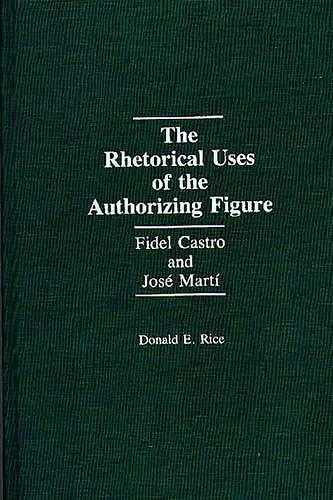The Rhetorical Uses of the Authorizing Figure
Fidel Castro and Jose Marti
Format:Hardback
Publisher:Bloomsbury Publishing PLC
Published:16th Jun '92
Currently unavailable, and unfortunately no date known when it will be back

Rice analyzes the rhetoric of the Cuban revolution and Fidel Castro's use of Jose Marti. He discusses how the authorizing figure defines and unifies the emerging revolutionary movement, contributes to the application of the sanctioning authority of the state, and legitimizes the revolutionary vision over time.
This study analyzes the rhetorical uses of the authorizing figure during the Cuban revolution. Rice discusses how the authorizing figure defines and unifies the emerging revolutionary movement and legitimizes the revolutionary vision over time.
One of the tools often used by a rhetor to motivate, solidify, and manage his constituency is the authorizing figure. While the referencing to historical figures is a common practice and frequently employed in the political realm, it takes on a special role in the inception, activation, and maintenance of social movements. This study analyzes the rhetorical uses of the authorizing figure during the Cuban revolution and Fidel Castro's use of Jose Marti, the civilian leader of the 1890s independence wars from Spain. Donald Rice discusses how the authorizing figure defines and unifies the emerging revolutionary movement, contributes to the application of the sanctioning authority of the state, and legitimizes the revolutionary vision over time.
These three uses provide the framework for the detailed analysis of Castro's discourse over the course of the revolution and its institutionalization, both representing and describing Castro's rehetorical strategy of using the past for present purposes. Chapter 1 is a discussion of the theoretical concepts of authority and authorization, which includes an explanation of the three-tiered approach used in the analysis. Chapter 2 gives a short history of Marti and a review of relevant Marti studies. Chapters 3, 4, and 5 contain the analyses of discourses relevant to Rice's established uses. Chapter 6, the concluding chapter, provides a synthesis of the preceding analyses and suggests areas of future research. These three uses provide the framework for the detailed analysis of Castro's discourse over the course of the revolution and its institutionalization, both representing and describing Castro's rhetorical strategy of using the past for present purposes.
ISBN: 9780275942144
Dimensions: unknown
Weight: unknown
192 pages